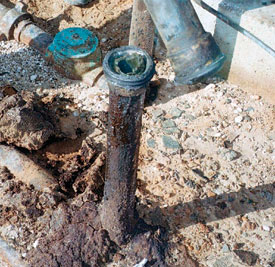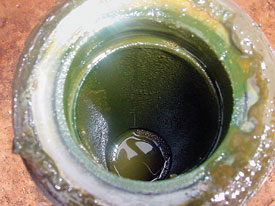Optimizing Production
New solution for paraffin
Field results indicate chemical treatment may provide long-term relief for a problem as old as the oil industry itself
Randy Bailey, Texas American Resources Co.; Larry Hambeck, Pioneer Natural Resources; and James R. Stewart, TexChem Group International L.L.C.
An innovative chemical, originally used to clean slop oil and storage tanks at refineries and storage terminals, has been adapted to control paraffin deposition in the producing industry. When introduced into a crude oil stream, it eliminates deposition of paraffin from the injection point forward in handling the crude. The product has been field tested in several multi-well fields.
This discussion of applications and case history results concludes that chemical treatment has successfully mitigated paraffin problems in areas where used, with significant savings for operators. A major attraction is that the product appears to provide a long-term solution. Besides pumping wells, treatments can also be applied to flowing, gas lift and plunger lift completions.
CHEMICAL PROPERTIES, APPLICATIONS
The product, adapted by the TexChem Group International L.L.C. of Houston, and named Production Enhancement Chemical (PEC), is a crystal modifier that satisfies the molecular ion deficiency that causes paraffin to adhere to surfaces it contacts.
The product is oil soluble, so water is not included in calculating the amount of chemical to be used in a treatment. Chemical concentration usually ranges from a high of 1,000 ppm or less, depending on crude oil type and paraffin content.
It is best to inject the chemical into a production stream before paraffin deposition begins to prevent any precipitation and coagulation of paraffin molecules. To attain a clean environment in a partially paraffined-up producing system, it is recommended that the well be hot oiled using 1/2 gal of chemical per bbl of hot oil.
With time and/or agitation, the chemical will also cause already deposited paraffin crystals to go back into solution. It is preferred to treat the oil before deposition, as will be demonstrated in the case histories. The economy of chemical use is determined by comparing its cost to that of hot-oil or hot-water treatments, and the time to perform such work and recover load fluids, plus interrupted production.
The chemical is being used in most US producing areas. It has been successful in all areas where used, when placed in a clean production system. It has low pour point, below – 40°F, allowing use in very cold climates. Table 1 outlines basic properties of the product.
| |
Table 1. Basic product properties |
|
| |
Specific gravity @ 60° (H2O = 1): 0.89 – 0 92 |
|
| |
Boiling point: <300°F |
|
| |
Vapor density (Air = 1.0): 8.0 |
|
| |
Vapor pressure (kPa & temp.): 6.2 kPa @ 100°F |
|
| |
Solubility in water: Insoluble |
|
| |
Flash point: 147°F |
|
| |
Pour point: >–40°F |
|
| |
Auto ignition: <350°F |
|
| |
Appearance: Clear dark amber liquid |
|
|
CASE HISTORIES
Texas American Resources operates the southeast Share Morrow field in the Texas Panhandle west of Perryton in Ochiltree County. Two wells are completed in the Morrow formation, which is 7,000 to 7,500 ft in depth.
Historically, these wells, producing 65° pour point crude, had significant paraffin accumulations in the upper part of their production strings, and in both 1-1/2-mi-long, 2-in. surface flowlines, requiring biweekly hot oil treatments. In December 2002, the operator started treating the wells with chemical, without applying the initial mix of 1/2 gal/bbl of hot oil. Instead, 55 gal of chemical was batched into the casing annulus of both wells.
| |
Table 2. Treatment savings,
Well 3902 |
|
| |
Formation: Morrow |
|
| |
Hot oil treatment, bbl: 60 |
|
| |
Recovery rate, bopd: 35 |
|
| |
Oil production, bopd: 35 |
|
| |
Price/bbl: $25.00 |
|
| |
Hot oil frequency: 14 days |
|
| |
Cost of hot oil job: $250.00 |
|
| |
Cost of chemical/gal: $19.85 |
|
| |
Saving per year: $36,570 |
|
|
Well 3902 produces 35 bpd of clean oil. Treatment now requires 5 quarts of chemical daily (850 ppm), continuously injected into the casing annulus. Treatment has eliminated the paraffin problem and the need for hot oiling, providing a savings of $36,570 per year, as shown in Table 2.
Well 4306 produces 140 bopd and 14 bwpd. After the initial 55-gal batch, the well is being treated with 14 quarts per day of chemical, (600 ppm based on oil/chemical ratios) injected continuously into the casing annulus. Application of chemical also eliminated the need for downhole hot oiling in this well and has provided a calculated savings of $74,700 per year.
Hot oiling of the 1-1/2-mi long flowline has been necessary during the winter due to a pour point problem when the oil cools on the surface. The well was pulled recently and rods and tubing were clean of any paraffin.
Pioneer Natural Resources' Windham G 1 well is completed in the Sprayberry at about 8,000 ft. The well was hot oiled every 45 days and often had to have rods pulled because of breaks from paraffin buildup in the tubing. Recommended treatment began in November 2000.
The well has produced for three years since continuous injection began, without hot oil or water treatments, providing a savings of $7,550 per year, excluding workover costs. The before and after photographs in Figs. 1 and 2 show a clean flowline five months after treatment began.
 |
Fig. 1. Well Windham G 1 paraffin buildup in tubing before treatment.
|
|
 |
Fig. 2. Well Windham G 1 after treatment.
|
|
A southwest Kansas operator has treated 39 wells in Hugoton field. These relatively shallow wells, at about 3,800 ft, responded to treatment with substantial production increases. The increases were attributed to eliminating paraffin that was plugging the formation face and subsequent hot oiling that forced paraffin farther into the producing zone. Results are shown in Table 3.
| |
Table 3. Treatment history of shallow
Hugoton field well in Southwest Kansas |
|
| |
Before treatment
|
|
| |
Oil production, bopd: 10 |
|
| |
Water production, bwpd: 10 |
|
| |
Hot oil frequency, days: 30 |
|
| |
|
|
| |
After treatment
|
|
| |
Oil production, bopd: 18 |
|
| |
Water production, bwpd: 10 |
|
| |
Hot oil frequency: None |
|
| |
Initial treatment: 55 gal down annulus |
|
| |
Daily treatment: 600 ppm down annulus |
|
|
Besides savings from eliminating hot oil treatments, higher production rates increased net revenue. Future plugging of the formation is now less likely to occur since hot oil treatments will not be forcing additional paraffin into the formation.
A southwest Nebraska operator, after hot oiling wells on a 14-day schedule, began chemical treatment of 40 completions in the fall of 2003. In this case, each well was batch treated biweekly. No hot oil supplements were needed during the recent colder-than-normal weather in the area. Calculated annual savings provided this operator should be in the range of $175,000. 
|




